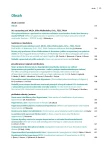White-coat hypertension and masked hypertension
Authors:
Jan Filipovský 1,2
Authors‘ workplace:
II. interní klinika LF a FN Plzeň, přednosta prof. MUDr. Jan Filipovský, CSc.
1; Biomedicínské centrum LF Plzeň, manažer doc. Ing. Jaroslav Hrabák, Ph. D.
2
Published in:
Vnitř Lék 2015; 61(5): 401-405
Category:
Reviews
Overview
White-coat hypertension (WCH) is very common: it is present in about one third of subjects with high office blood pressure (BP). A typical patient is a non-smoking female at higher age. Prognostic data are not very reliable because most patients are treated on the basis of elevated office BP; some long-term studies have shown that cardiovascular (CV) risk is increased compared to normotensives. The opposite disorder is masked hypertension (MH). Its prevalence in population-based studies is 13 %. MH is common in males, typically aged between 30 and 50 years, smokers with unfavorable risk profile, and it is also frequent in diabetics. The risk of future cardiovascular events is close to that of sustained hypertensives. It is important to search for MH actively, therefore, we should recommend home BP measurements also to those subjects whose office BP is normal. We do not have any prospective data about treatment of either WCH or MH. In subjects with low CV risk, only nonpharmacologic treatment may be initiated – in this case, however, the patient must be followed closely including out-of-office BP measurements; in those subjects where other CV risk factors and/or target organ damage are present, drug treatment should be considered, but as we have no evidence, only empirical approach is possible.
Key words:
ambulatory blood pressure monitoring – diagnosis – masked hypertension – prognosis – treatment – white-coat hypertension
Sources
1. Pickering TG, James GD, Boddie C et al. How common is white coat hypertension? JAMA 1988; 259(2): 225–228.
2. Pickering TG, Davidson K, Gerin W et al. Masked hypertension. Hypertension 2002; 40(6): 795–796.
3. Staessen JA, O’Brien ET, Amery AK et al. Ambulatory blood pressure in normotensive and hypertensive subjects: results from an international database. J Hypertens Suppl 1994; 12(7): S1-S12.
4. Fagard RH, Cornelissen VA. Incidence of cardiovascular events in white-coat, masked and sustained hypertension versus true normotension: a meta-analysis. J Hypertens 2007; 25(11): 2193–2198.
5. Conen D, Aeschbacher S, Thijs L et al. Age-specific differences between conventional and ambulatory daytime blood pressure values. Hypertension 2014; 64(5): 1073–1079.
6. Cuspidi C, Meani S, Sala C et al. How reliable is isolated clinical hypertension defined by a single 24-h ambulatory blood pressure monitoring? J Hypertens 2007; 25(2): 315–320.
7. Mancia G, Bombelli M, Facchetti R et al. Long-term risk of sustained hypertension in white-coat or masked hypertension. Hypertension 2009; 54(2): 226–232.
8. Schillaci G, Pucci G, Pirro M et al. Combined effects of office and 24-h blood pressure on aortic stiffness in human hypertension. J Hypertens 2011, 29(5): 869–875.
9. Mancia G, Bombelli M, Facchetti R et al. Increased long-term risk of new-onset diabetes mellitus in white-coat and masked hypertension. J Hypertens 2009; 27(8): 1672–1678.
10. Franklin SS, Thijs L, Li Y et al. International Database on Ambulatory blood pressure in relation to Cardiovascular Outcomes (IDACO) Investigators. Masked hypertension in diabetes mellitus: treatment implications for clinical practice. Hypertension 2013; 61(5): 964–971.
11. Verdecchia P, Reboldi GP, Angeli F et al. Short - and long-term incidence of stroke in white-coat hypertension. Hypertension 2005; 45(2): 203–208.
12. Fagard RH, Staessen JA, Thijs L et al. Response to antihypertensive therapy in older patients with sustained and nonsustained systolic hypertension. Circulation 2000; 102(10): 1139–1144.
13. Mancia G, Fagard R, Narkiewicz K et al. 2013 ESH/ESC Guidelines for the management of arterial hypertension: the Task Force for the management of arterial hypertension of the European Society of Hypertension (ESH) and of the European Society of Cardiology (ESC). J Hyperten 2013; 31(7): 1281–1357.
Labels
Diabetology Endocrinology Internal medicineArticle was published in
Internal Medicine

2015 Issue 5
Most read in this issue
- Hyperosmolar hyperglycemic state
- Hemocoagulation – New views on the old cascade
- The role of uric acid and allopurinol therapy in cardiovascular disease
- Hypertension in females
